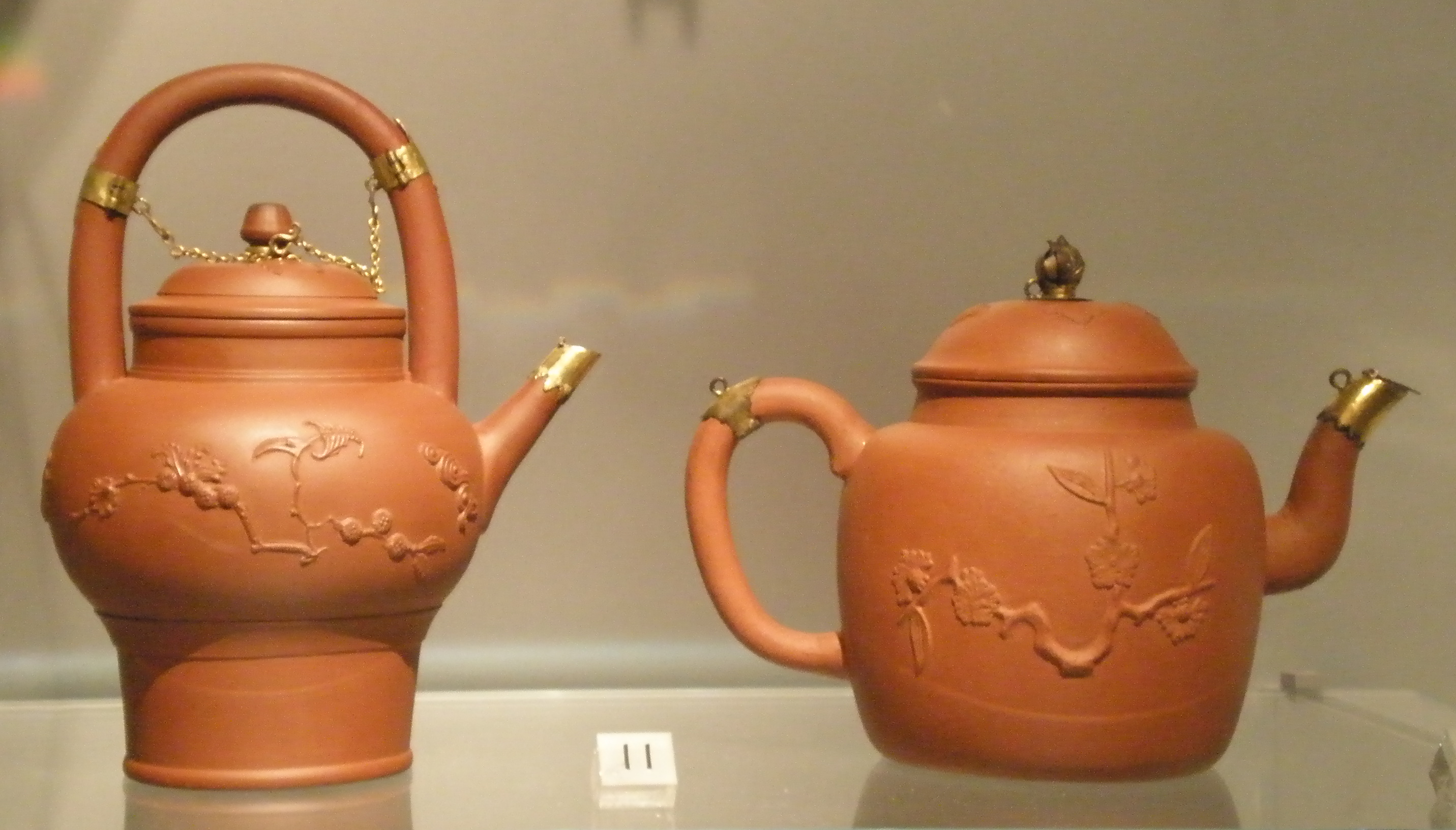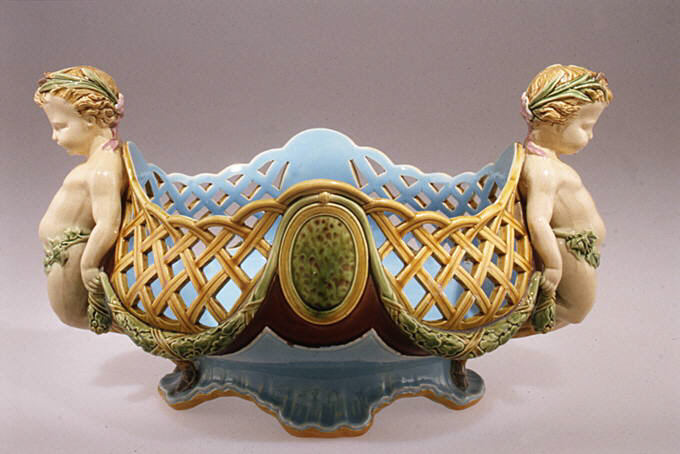|
Pâte-sur-pâte
''Pâte-sur-pâte'' is a French term meaning "paste on paste". It is a method of porcelain decoration in which a relief design is created on an unfired, unglazed body, usually with a coloured body, by applying successive layers of (usually) white porcelain slip (liquid clay) with a brush. Once the main shape is built up, it is carved away to give fine detail, before the piece is fired. The work is very painstaking and may take weeks of adding extra layers and allowing them to harden before the next is applied. The usual colour scheme is a white relief on a contrasting coloured background, which in England was often Parian ware. The effect is somewhat similar to other types of relief decoration, in particular sprigging. However, unlike Jasperware, for example, a mould is not normally used, and the ceramic artist is able to achieve translucency. The method also gives results resembling cameos in stone or cameo glass. The development of pâte-sur-pâte dates back to 1850 in Fran ... [...More Info...] [...Related Items...] OR: [Wikipedia] [Google] [Baidu] |
Marc-Louis Solon
Marc-Louis-Emmanuel Solon (1835 – 23 June 1913), pseudonym ''Miles'', was a renowned French porcelain artist. After beginning his career at the Sèvres Pottery, he moved to Stoke-on-Trent in 1870 to work at Mintons Ltd, where he became the leading exponent of the technique of ceramic decoration called ''pâte-sur-pâte''. His work commanded high prices in the late Victorian period. Solon was born in Montauban, Tarn-et-Garonne. After moving to England at the time of the Franco-Prussian War he lived there for the rest of his life. Family Solon married Laure, the daughter of Minton's art director, Léon Arnoux, and the Solons raised a large family in The Villas near the Mintons factory. Their eldest son, Léon-Victor Solon (1872–1957), joined Minton in the 1890s and became art director (1900–1909). Leon made an important contribution to art nouveau ceramics at Minton before moving to the United States. (accessed via JSTOR, subscription required) Other notable sons include ... [...More Info...] [...Related Items...] OR: [Wikipedia] [Google] [Baidu] |
Sprigging (decorative)
Sprigging or sprigged decoration is a technique for decorating pottery with low relief shapes made separately from the main body and applied to it before firing. Usually thin press moulded shapes are applied to greenware or bisque. The resulting pottery is termed sprigged ware, and the added piece is a "sprig". The technique may also be described by terms such as "applied relief decoration", especially in non-European pottery. The alternative way to achieve similar effects without sprigging is to mould the whole body, which is also common. Pâte-sur-pâte is a very labour-intensive, and so expensive, method of producing similar, but more refined, effects in contrasting colors, invented in China and then in France in the mid-19th century. Technique The clay body for the sprig is pushed into the mould, the back scraped flat, then released on a damp cloth pad. The greenware is wetted lightly with a brush, and the sprig is pressed lightly with another cloth pad to push out wat ... [...More Info...] [...Related Items...] OR: [Wikipedia] [Google] [Baidu] |
Pottery
Pottery is the process and the products of forming vessels and other objects with clay and other ceramic materials, which are fired at high temperatures to give them a hard and durable form. Major types include earthenware, stoneware and porcelain. The place where such wares are made by a ''potter'' is also called a ''pottery'' (plural "potteries"). The definition of ''pottery'', used by the ASTM International, is "all fired ceramic wares that contain clay when formed, except technical, structural, and refractory products". In art history and archaeology, especially of ancient and prehistoric periods, "pottery" often means vessels only, and sculpted figurines of the same material are called "terracottas". Pottery is one of the oldest human inventions, originating before the Neolithic period, with ceramic objects like the Gravettian culture Venus of Dolní Věstonice figurine discovered in the Czech Republic dating back to 29,000–25,000 BC, and pottery vessels that were ... [...More Info...] [...Related Items...] OR: [Wikipedia] [Google] [Baidu] |
Art Nouveau
Art Nouveau (; ) is an international style of art, architecture, and applied art, especially the decorative arts. The style is known by different names in different languages: in German, in Italian, in Catalan, and also known as the Modern Style (British Art Nouveau style), Modern Style in English. It was popular between 1890 and 1910 during the Belle Époque period, and was a reaction against the academic art, eclecticism and historicism of 19th century architecture and decoration. It was often inspired by natural forms such as the sinuous curves of plants and flowers. Other characteristics of Art Nouveau were a sense of dynamism and movement, often given by asymmetry or whiplash lines, and the use of modern materials, particularly iron, glass, ceramics and later concrete, to create unusual forms and larger open spaces.Sembach, Klaus-Jürgen, ''L'Art Nouveau'' (2013), pp. 8–30 One major objective of Art Nouveau was to break down the traditional distinction between fine ... [...More Info...] [...Related Items...] OR: [Wikipedia] [Google] [Baidu] |
Tubelining
Tubelining is a technique of ceramic decoration. It involves squeezing a thin line of clay body through a nozzle onto the ware being decorated. An alternative term is "slip trailing". The skill takes time to acquire and it is associated with art pottery rather than mass production. UK production Tubelining has been used by a number of firms in the Staffordshire Potteries. ; the website of the is a good resource for comparing the tubelining of Staffordshire firms. In particular, the |
Mintons
Mintons was a major company in Staffordshire pottery, "Europe's leading ceramic factory during the Victorian era", an independent business from 1793 to 1968. It was a leader in ceramic design, working in a number of different ceramic bodies, decorative techniques, and "a glorious pot-pourri of styles - Rococo shapes with Oriental motifs, Classical shapes with Medieval designs and Art Nouveau borders were among the many wonderful concoctions". As well as pottery vessels and sculptures, the firm was a leading manufacturer of tiles and other architectural ceramics, producing work for both the Houses of Parliament and United States Capitol. The family continued to control the business until the mid-20th century. Mintons had the usual Staffordshire variety of company and trading names over the years, and the products of all periods are generally referred to as either "Minton", as in "Minton china", or "Mintons", the mark used on many. Mintons Ltd was the company name from 1879 o ... [...More Info...] [...Related Items...] OR: [Wikipedia] [Google] [Baidu] |
Pair Of Vases, View 1, Marc-Louis-Emmanuel Solon, Minton Factory, England, 1880, Porcelain, Polychromy, Gilding, Bronze Bases - Mount Holyoke College Art Museum - DSC04599
Pair or PAIR or Pairing may refer to: Government and politics * Pair (parliamentary convention), matching of members unable to attend, so as not to change the voting margin * ''Pair'', a member of the Prussian House of Lords * ''Pair'', the French equivalent of peer, holder of a French Pairie, a French high title roughly equivalent to a member of the British peerage Mathematics * 2 (number), two of something, a pair * 2-tuple, in mathematics and set theory * Ordered pair, in mathematics and set theory * Pairing, in mathematics, an R-bilinear map of modules, where R is the underlying ring * Pair type, in programming languages and type theory, a product type with two component types * Topological pair, an inclusion of topological spaces Science and technology * Couple (app), formerly Pair, a mobile application for two people * PAIR (puncture-aspiration-injection-reaspiration), in medicine * Pairing, a handshaking process in Bluetooth communications * Pair programming, an agile soft ... [...More Info...] [...Related Items...] OR: [Wikipedia] [Google] [Baidu] |
Stoke-on-Trent
Stoke-on-Trent (often abbreviated to Stoke) is a city and Unitary authorities of England, unitary authority area in Staffordshire, England, with an area of . In 2019, the city had an estimated population of 256,375. It is the largest settlement in Staffordshire and is surrounded by the towns of Newcastle-under-Lyme, Alsager, Kidsgrove, Biddulph and Stone, Staffordshire, Stone, which form a conurbation around the city. Stoke is wikt:polycentric, polycentric, having been formed by Federation of Stoke-on-Trent, the federation of six towns in 1910. It took its name from Stoke-upon-Trent where the main centre of government and the principal Stoke-on-Trent railway station, railway station in the district were located. Hanley, Staffordshire, Hanley is the primary commercial centre; the other four towns which form the city are Burslem, Tunstall, Staffordshire, Tunstall, Longton, Staffordshire, Longton and Fenton, Staffordshire, Fenton. Stoke-on-Trent is the home of the pottery industr ... [...More Info...] [...Related Items...] OR: [Wikipedia] [Google] [Baidu] |
Frederick Alfred Rhead
Frederick Alfred Rhead (1856–1933) was a potter working in North Staffordshire, England. He is not to be confused with his son Frederick Hurten Rhead (1880–1942) who was also a potter, and who worked mainly in the USA. His other children included the pottery designer Charlotte Rhead. Rhead's father, G.W. Rhead, worked in the pottery industry, and young Frederick was apprenticed at Mintons Ltd. He was one of a number of apprentices who in the 1870s learnt the art of ''pâte-sur-pâte'' decoration from Marc-Louis Solon, a French émigré who was the leading exponent of this ceramic technique. Rhead continued to work in ''pâte-sur-pâte'' after leaving Minton. He joined Wedgwood and went on to work at a number of potteries including a failed venture of his own. His most famous piece of ceramics is the "Gladstone Vase" which was presented to William Ewart Gladstone by the Liberals of Burslem in 1888. The vase is on public view, having been loaned to the Gladstone Pottery Museu ... [...More Info...] [...Related Items...] OR: [Wikipedia] [Google] [Baidu] |
The Villas
The Villas, Stoke-on-Trent, is an estate of 24 Victorian houses in Stoke-upon-Trent, England. Originally a distinct settlement set in green fields, it now merges with the late 19th- and early 20th-century suburban sprawl along London Road below Penkhull village on the outskirts of Stoke-on-Trent and within the ward of Stoke and Trent Vale. Most dating from 1851 to 1855, The Villas was designed by local architect Charles Lynam, who became a prominent architect in Staffordshire, building the Minton Hollins tileworks, for example. In designing The Villas, he chose an Italianate style similar to other Staffordshire buildings, such as Trentham Hall and Alton Towers railway station. In June 1850, a number of prominent inhabitants of Stoke formed "The Stokeville Building Society". The purpose of the building society was to provide the means and the financial capability for its members to erect, and ultimately own, houses on copyhold land outside the town of Stoke-upon-Trent. The l ... [...More Info...] [...Related Items...] OR: [Wikipedia] [Google] [Baidu] |
Albert-Ernest Carrier-Belleuse
Albert-Ernest Carrier-Belleuse (born Albert-Ernest Carrier de Belleuse; 12 June 1824 – 4 June 1887) was a French sculptor. He was one of the founding members of the Société Nationale des Beaux-Arts, and was made an officer of the Legion of Honour. Early life Carrier-Belleuse was born on 12 June 1824 at Anizy-le-Château, Aisne, France. He began his training as a goldsmith's apprentice. Carrier-Belleuse was a student of David d'Angers and briefly studied at the École des Beaux-Arts. His career is distinguished by his versatility and his work outside France: in England between 1850 and 1855 (working for Mintons), and in Brussels around 1871. His name is perhaps best known because Auguste Rodin worked as his assistant between 1864 and 1870. The two travelled to Brussels in 1871, and by some accounts Rodin assisted Carrier-Belleuse's architectural sculpture for the Brussels Stock Exchange. Career Carrier-Belleuse made many terra cotta pieces, the most famous of which may be ... [...More Info...] [...Related Items...] OR: [Wikipedia] [Google] [Baidu] |





_-_(5217558781)_(2).jpg)